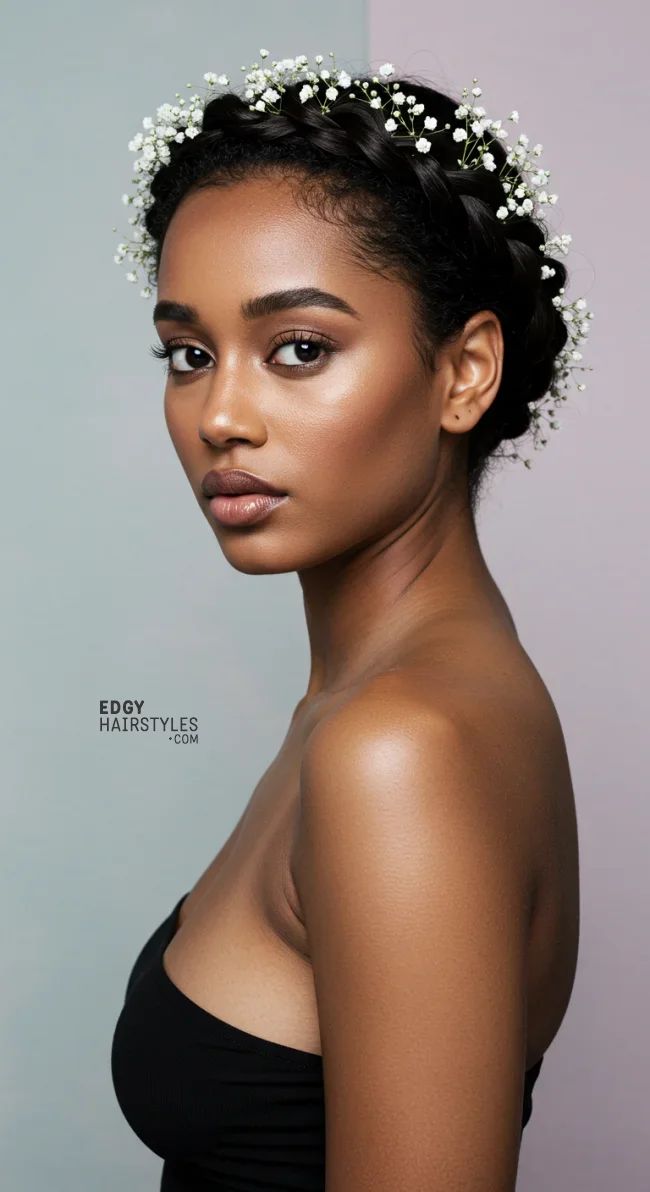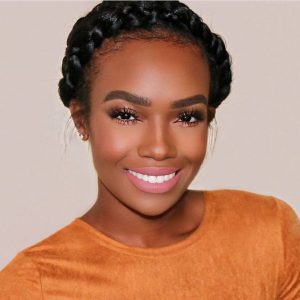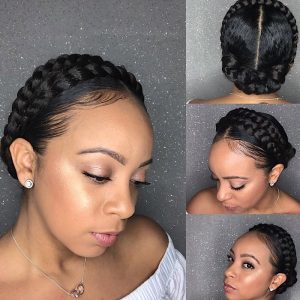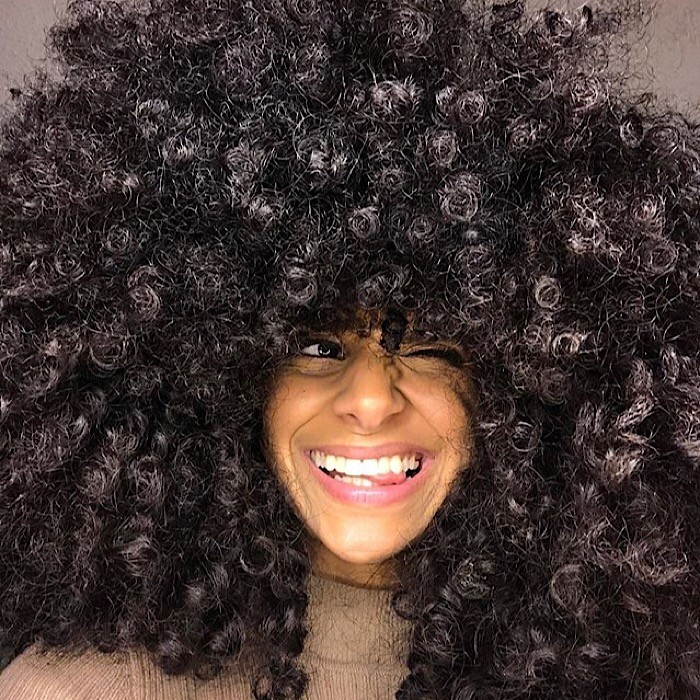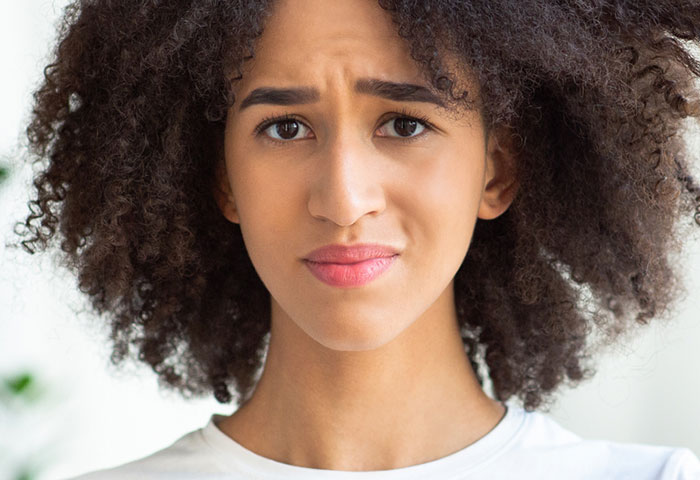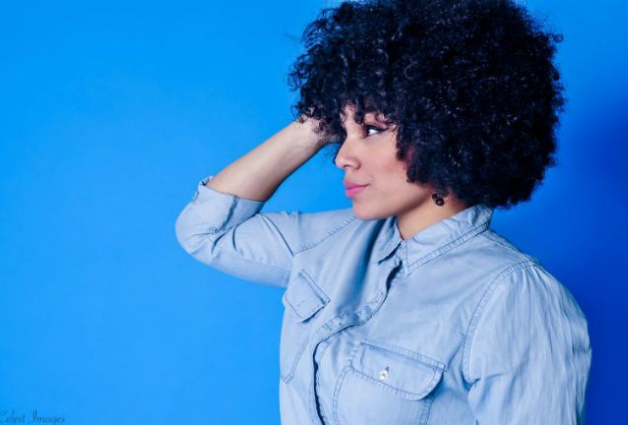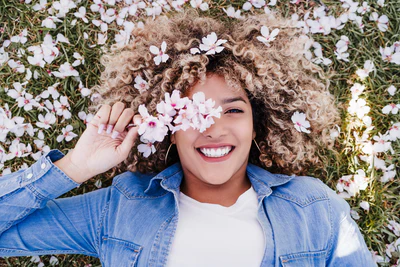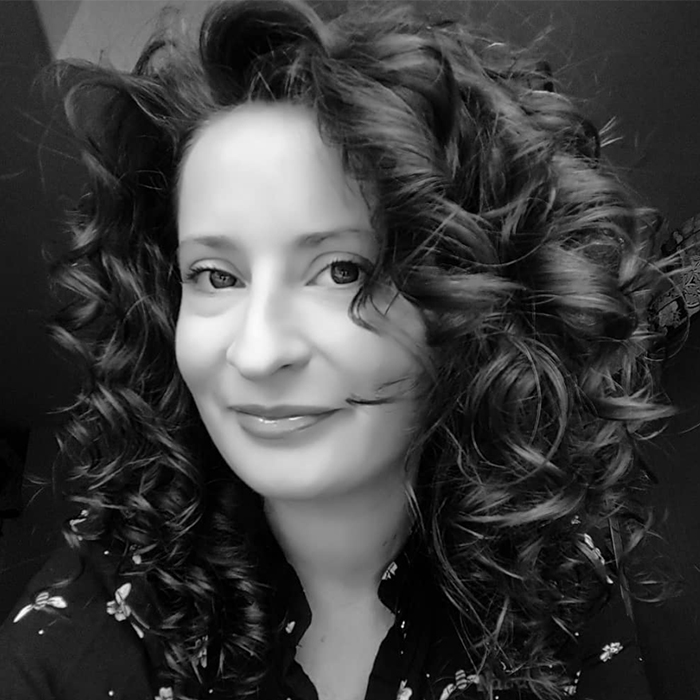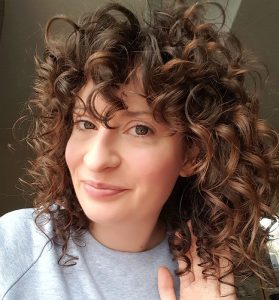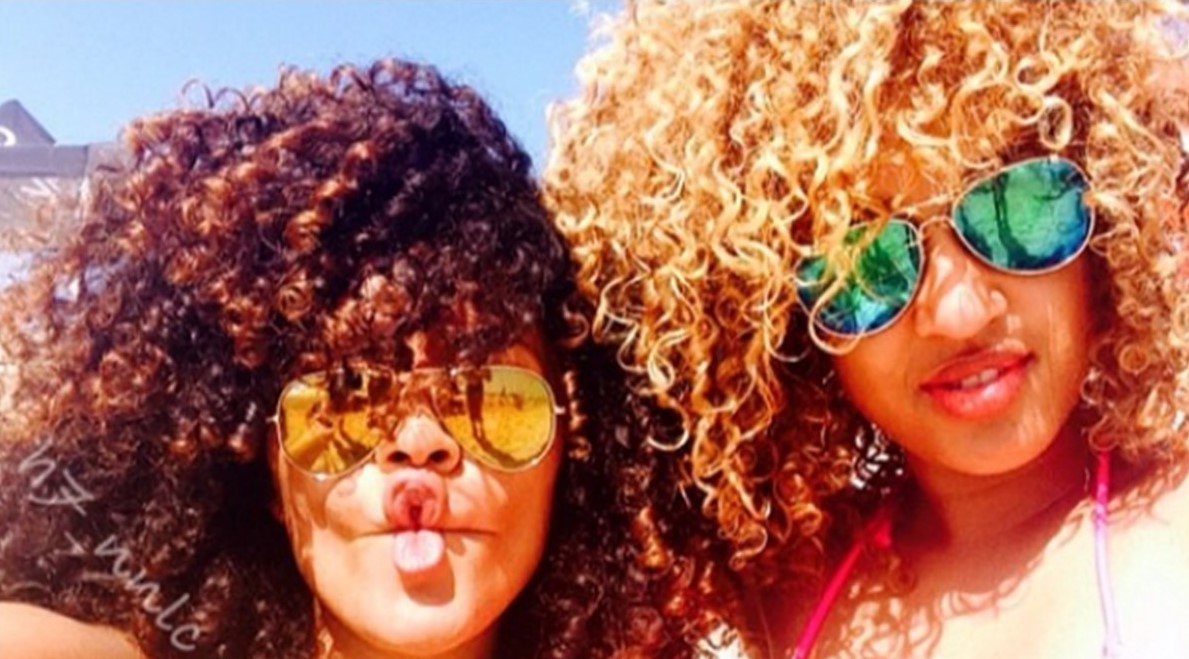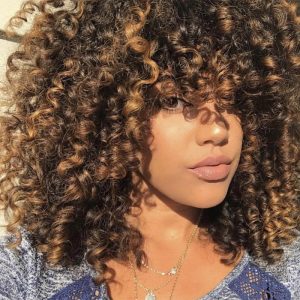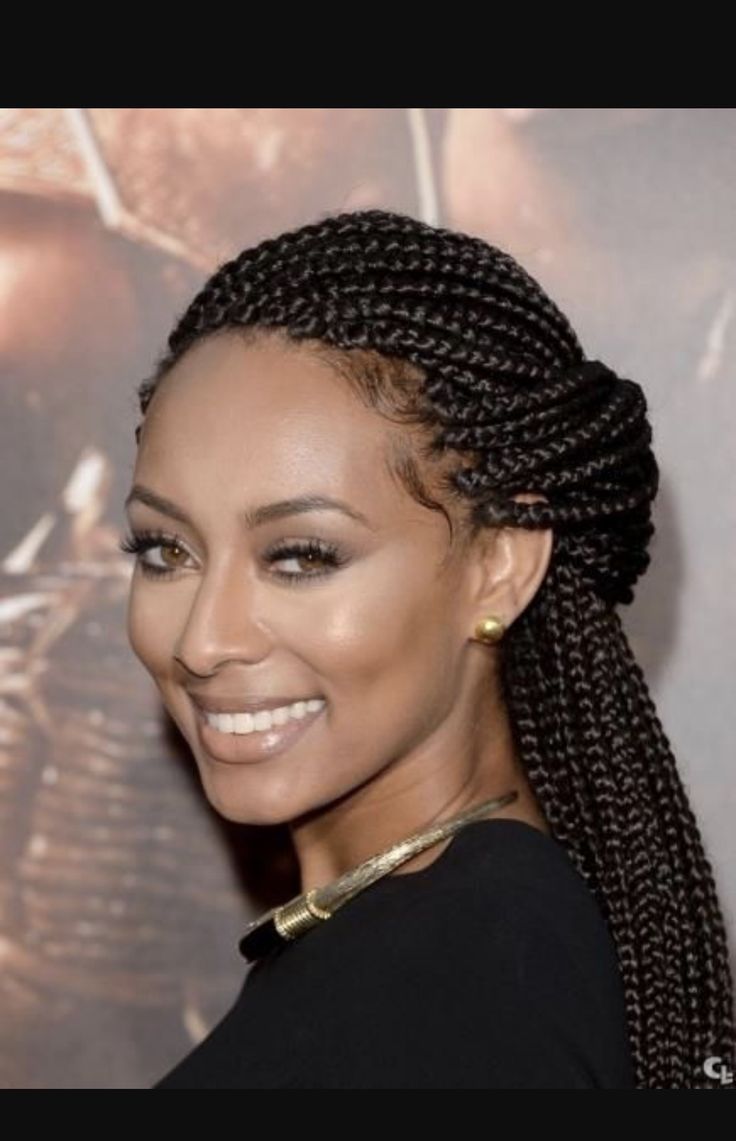Tales of Texture: Jui Embraces Her Texture
Having textured hair as a child, how did it affect you?
As a kid I didn’t pay too much attention to my textured hair. I do have curlies in my family, my mom & aunt have always worn their natural textured hair without changing it or flat ironing it. It was more important to focus on school and extracurricular activities than appearance when I was growing up. We got to enjoy our childhood without the pressures a lot of kids face today. It was about the time I went to college that it became a challenge. The most common response you got in a salon was – Why don’t you straighten it.. There was no accessible information on how to take care of textured hair.
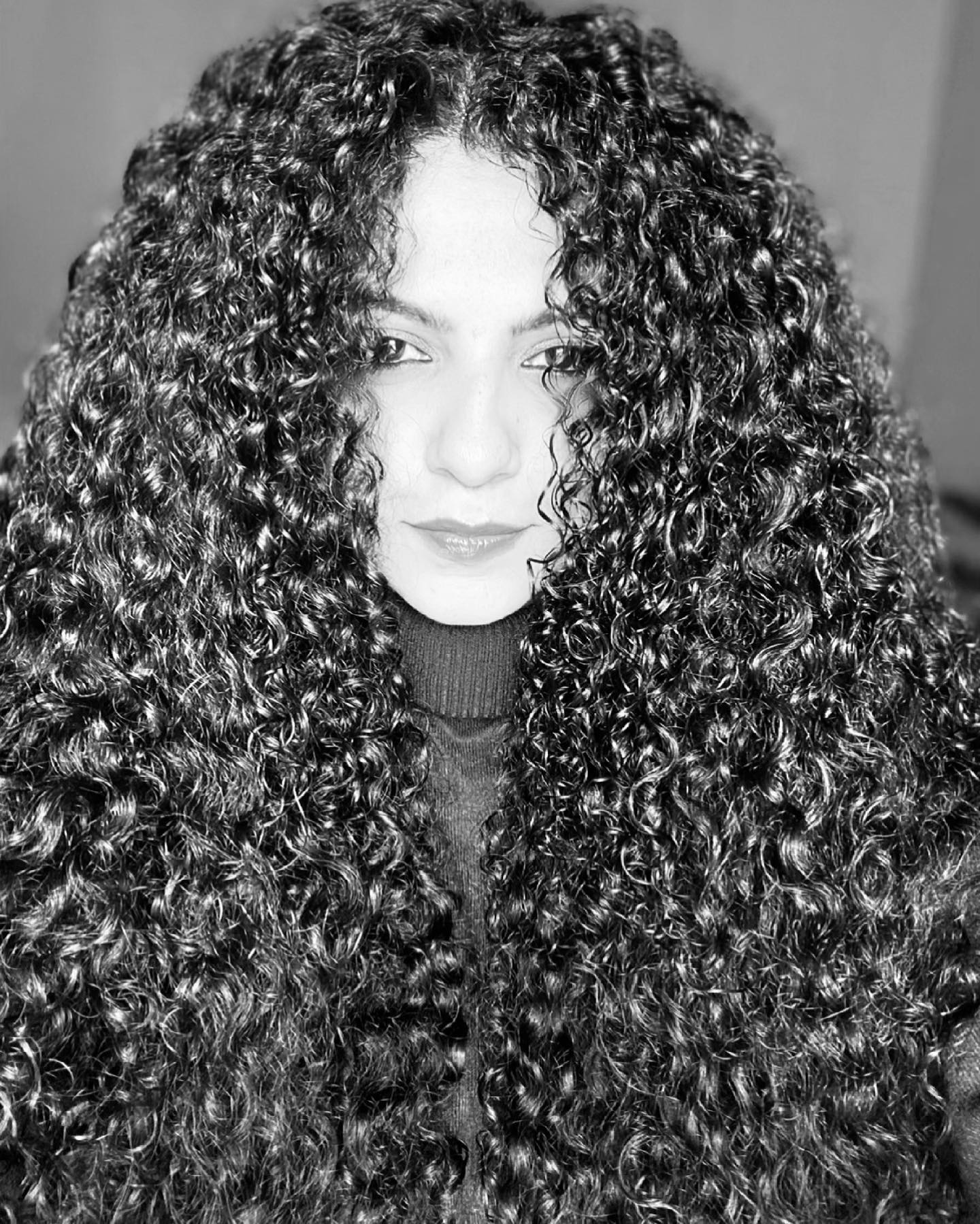
How did you come to embrace your naturally curly hair?
Just before I joined my first job, I had my hair chemically straightened. This was more related to conventional beauty standards and the perception that if you wanted to look professional, your hair had to be sleek and straight. So, I straightened my hair for 7-8 years. Eventually I got over the poker straight-haired look. Naturally straight hair looks good as does all types of hair textures, but my straightened hair looked ‘artificial’.
In your natural hair journey, what has been the most empowering moment?
Realizing that my natural textured hair made me feel more like myself! Some women have told me they showed my curly haired picture to their little girls & that they loved it & wanted to grow their own natural curly hair instead of wishing for straight hair.
What is the best way to protect your curls at night?
I use a satin bonnet or use a satin pillowcase.
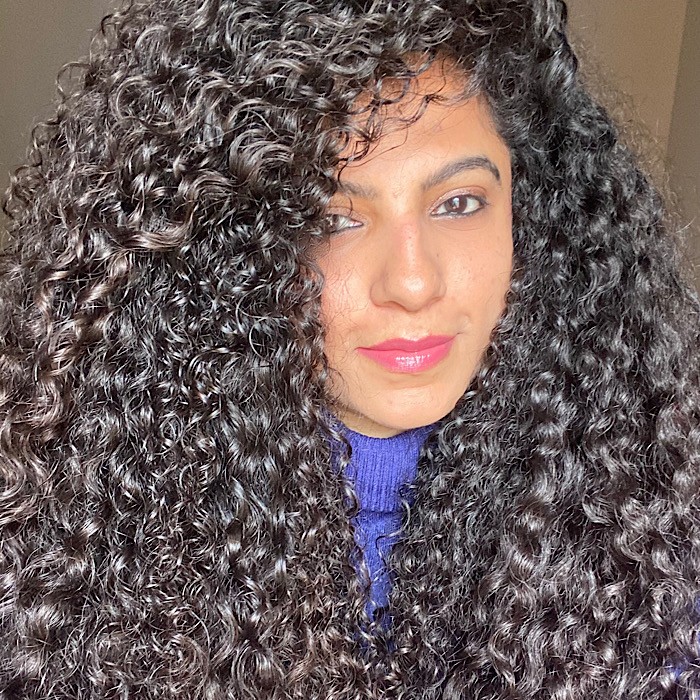
Do you have an essential curly girl you can’t live without?
Conditioner and Leave – in.
What is your current hair regimen? Any favorite products you’d like to share?
I try to follow the Curly Girl Method. You have to figure out what suits your hair the best.
Suggested products:
- Oil – 30-40 mins prior to hair wash
Difeel Premium Natural Jojoba Oil
Mielle Mint Almond Oil - Shampoo
Kinky Curly Come Clean Shampoo - I detangle my hair after applying conditioner. I gently scrunch my hair while rinsing.
Kinky Knot Today - I try to Deep Condition at least a couple of times a month. I prefer to Deep Condition on clean hair.
TGIN Honey Miracle Hair Mask - I use a microfiber towel or cap after rinsing & style my hair while it’s very damp.
Cantu Microfiber Drying Cap
Donna Microfiber Turban - In most cases, I prefer to let my hair air dry after I’ve styled it.

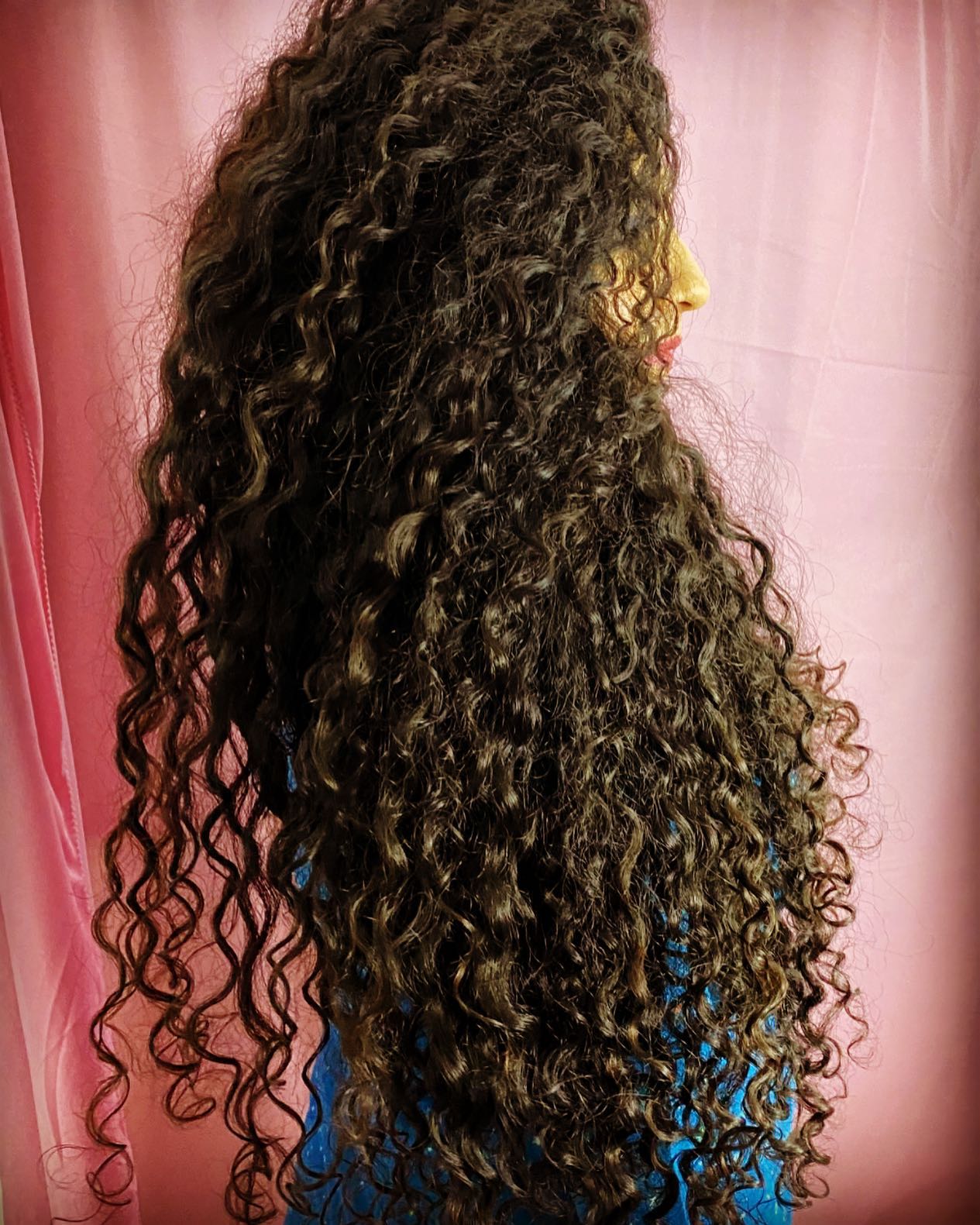
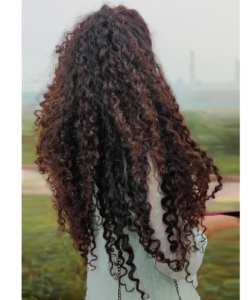
Do you have any advice for women who are struggling to love their natural texture?
Embrace your natural curls, and texture – frizz et al! Make the Curly Girl Method part of your life and don’t let it get in the way of your life! Finally, the Bigger the Hair, the Bigger the Dream!
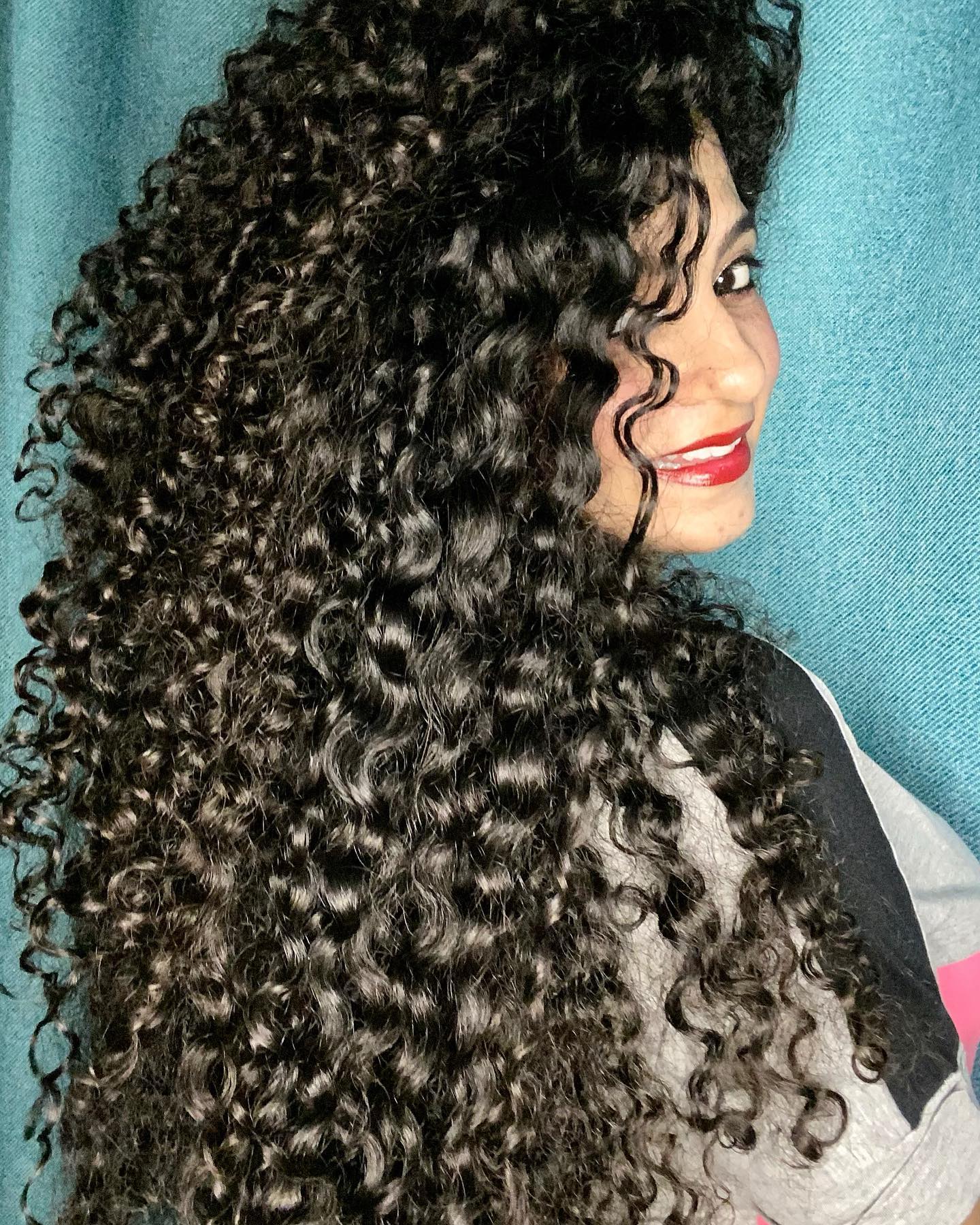
Mastering the Halo Braid: A Complete Fall-Ready Guide
What is a Halo Braid?
A halo braid is a beautiful plaited protective hairstyle created when a cornrow-style braid (or long Dutch braid) wraps around your head.
A great option for the holidays that is quick and easy and can be styled on naturally curly hair as well as all other hair types is the halo braid. The style creates a “halo effect,” hence the name halo braid. You can dress it up or down. You can also add some hair jewelry to give your hair some flair! You can never go wrong with a sleek halo braid.
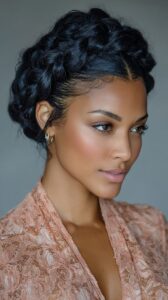 Gather Your Supplies
Gather Your Supplies
Before you jump into the styling process, make sure you have all the supplies you need. Doing this will make the process much quicker and easier to help you to achieve this flawless look in no time.
Hair Prep Supplies 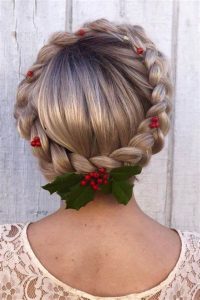
- Clarifying Shampoo
- Moisturizing Shampoo
- Moisturizing Conditioner
- Leave-In Conditioner, Oil, or other moisturizing products of your choice
Hair Stretching Supplies
- Hair Bands
- Blow dryer
Styling Supplies
- Edge control (for use with natural hair textures)
- Wide-tooth comb
- Rattail comb
- Denman Brush (for use with natural hair textures)
- Bobby Pins
- Edge Brush
Prepare Your Hair for a Halo Braid
Doing a protective style on unwashed, dry hair is not a good idea. It can lead to excessive pulling, snapped-off strands, pain, and a not-so-great result.
Hair prep includes cleaning your hair to get rid of product buildup, conditioning to nourish the strands, and moisturizing to ensure your hair stays happy and healthy while the style is in place.
Shampoo Your Hair
The first step to preparing your hair for a protective style is to wash it. First, wet your hair and apply a clarifying shampoo. This type of shampoo is best for removing product buildup from your hair.
When shampooing, be sure to focus on your roots, and let the shampoo work down to the ends on its own. Applying shampoo directly to your ends can cause tangles and unnecessary dryness.
Next, rinse out the clarifying shampoo and, if you have time, repeat the process with a moisturizing shampoo. This will replace some of the moisture that the clarifying shampoo may have taken away, prevent tangles, and ensure your hair is clean.
We recommend staying away from shampoos formulated with sulfates, drying alcohols, or parabens.
Condition Your Hair
Next, follow up with a moisturizing conditioner or deep conditioner. This time focus the product on your ends rather than your roots, as your ends need the most moisture. While your hair is coated in conditioner, detangle it with a wide-toothed comb or denman brush. If using a regular rinse-out conditioner, follow the instructions on the product label for the best results. When using a deep conditioner, allow the product to sit in your hair for 15 mins or more. You can even put a shower cap on to trap the heat from your scalp and boost the penetration of the moisturizing treatment. When rinsing out the conditioner, try to use cold water, as cooler temperatures will close up your hair’s cuticles and lock in the moisture.
Here are some great shampoos and conditioners for curly hair:
- Alikay Naturals Caribbean Coconut Milk Shampoo
- Mixed Roots Compounds Curl Cleansing Shampoo
- Palmer’s Moisture Boost Conditioner
- The Doux Ladies First Honey Shampoo
- Creme of Nature Argan Oil Creamy Hydration Co-Wash
Moisturize Your Hair
After you are done shampooing and conditioning your hair, be sure to use moisturizing products, including moisturizing cream, an oil, a leave-in conditioner, or all three! It is often best to apply these products while your hair is still soaking wet, as this ensures that your hair is getting as much moisture as possible. One popular method of moisturizing curly natural hair is the “LOC Method.”
- L – Start with a leave-in conditioner.
- O – Next, apply oil to lock in the moisture from the leave-in.
- C – Finish it off with a cream to seal the hair cuticle and maintain the moisture in your hair.

Here are some great moisturizers for curly hair:
- SheaMoisture Curl and Style Milk
- The Mane Choice H2O Hydration Therapy Intense Nourishing Leave In Conditioner
- Tropic Isle Living Jamaican Black Castor Oil
- Carol’s Daughter Black Vanilla Leave-in
Stretch Your Hair if Your Hair Is Textured
Stretching your hair can prevent knots and tangles and make it easier to do your halo braid. Multiple methods can be used to stretch your hair. You can try the banding method, blow drying your hair with Tension or braiding your hair to prepare your hair for the halo braid.
Instruction on creating your Halo Braid
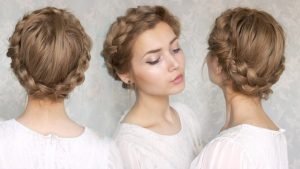 Read below the detailed steps on how to complete a halo braid:
Read below the detailed steps on how to complete a halo braid:
- Use a styling gel or cream and an edge brush or toothbrush to lay your edges down.
- Part your hair at the crown of your head at the highest point. Comb the hair away from the crown of your head in a bowl shape all the way around.
- Part your hair from about 2 inches behind your ear to the crown of your head. This will be the beginning of your braid.
- Begin to braid, incorporating medium-sized sections of your own hair into the braid as you braid around your head. Because you are using your natural hair, the braid shouldn’t be too tight. This will allow you to achieve a fuller look with your braid.
- *Helpful Tip: Be sure to smooth out your hair as you braid. Doing this will prevent tangles and keep the braid looking neat.
- Continue braiding all the way around your head until all of your hair has been incorporated into the braid, and you’ve reached the ends of your hair.
- Tuck the end of the braid underneath your completed halo braid, either above or below it. Use bobby pins to secure it into place.
- Tuck away any flyaways or smooth them down with product, and you are all finished!
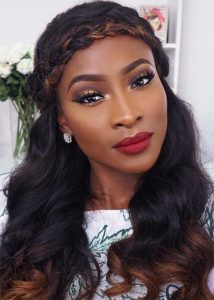
Dos and Don’ts of the Halo Braid
Refer to the below dos and don’ts of halo braid styling to help prevent mistakes and frustration in your styling process.
Do
-
Use as much moisturizing product as you feel your hair needs before and during the styling process to ensure the style will stay in place with little frizz or flyaways.
-
Be aware of how much tension is being applied as you braid. If the braid is too tight, this can cause damage to your scalp and hairline.
Don’t
-
Skip out on the steps to prepare your hair before this style. It can be tempting to jump right into styling, especially if you’re in a hurry, but taking the time to properly care for your hair beforehand will ensure that the style actually protects your hair rather than cause damage.
-
Use the entire length of your extension hair without trimming it. This will make the end of the braid very thick and difficult to tuck away.
-
Get your hair wet after styling. Your natural hair will curl up, causing frizz.
If your curls, coils or waves...
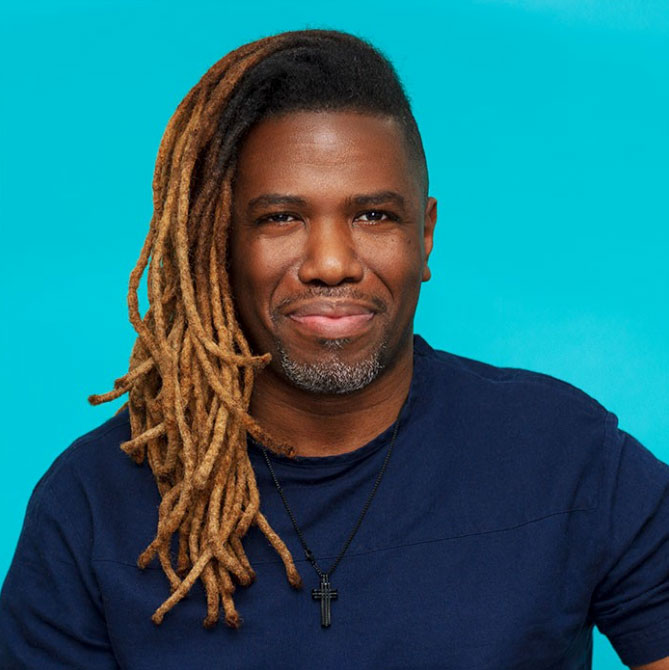
If your curls, coils or waves have spent the last year up in a pineapple pony, you’re not alone. This summer has us feeling inspired and confident to give our curls the love and attention they deserve. We have recently been introduced to new products to test, fun haircuts to try, and bold semi permanent colors to experiment with! One line of products we’re most excited to share with the NaturallyCurly community is Beautiful Curls by Alaffia.
Alaffia offers natural, plant-based and fair trade products for skin and body. This year, they released a line of products specifically formulated for textured hair. There’s a wavy/curly range, a curly/kinky range, and products to bring definition to all curl patterns and porosities. If you’ve been taking a closer look at your ingredient lists, you’ll be happy to know that Beautiful Curls contains no silicones, sulfates, parabens, phthalates, synthetic fragrances, artificial coloring or mineral oil—AND it’s cruelty-free! Additionally, many of the ingredients are sourced from Alaffia’s West African women’s cooperatives, which handcraft indigenous ingredients such as unrefined shea butter, coconut oil, neem oil, and African black soap. All for less than $15 each.
Here to share how we can achieve our best definition this summer is Celebrity Hairstylist and Alaffia Brand Ambassador, Allyn Antoine. He’s been working with textured hair for over 20 years in New York City’s top-tier salons and you’ve seen his work on the big screen, TV shows, magazines and more. We brought Antoine some of your top curl concerns from making a twist-out last to the frizz-causing mistakes to avoid, here are the expert tips he had for us.
One line of products we’re most excited to share with the NaturallyCurly community is Beautiful Curls by Alaffia.
Alaffia offers natural, plant-based and fair trade products for skin and body. This year, they released a line of products specifically formulated for textured hair. There’s a wavy/curly range, a curly/kinky range, and products to bring definition to all curl patterns and porosities. If you’ve been taking a closer look at your ingredient lists, you’ll be happy to know that Beautiful Curls contains no silicones, sulfates, parabens, phthalates, synthetic fragrances, artificial coloring or mineral oil—AND it’s cruelty-free! Additionally, many of the ingredients are sourced from Alaffia’s West African women’s cooperatives, which handcraft indigenous ingredients such as unrefined shea butter, coconut oil, neem oil, and African black soap. All for less than $15 each.
Here to share how we can achieve our best definition this summer is Celebrity Hairstylist and Alaffia Brand Ambassador, Allyn Antoine. He’s been working with textured hair for over 20 years in New York City’s top-tier salons and you’ve seen his work on the big screen, TV shows, magazines and more. We brought Antoine some of your top curl concerns from making a twist-out last to the frizz-causing mistakes to avoid, here are the expert tips he had for us.
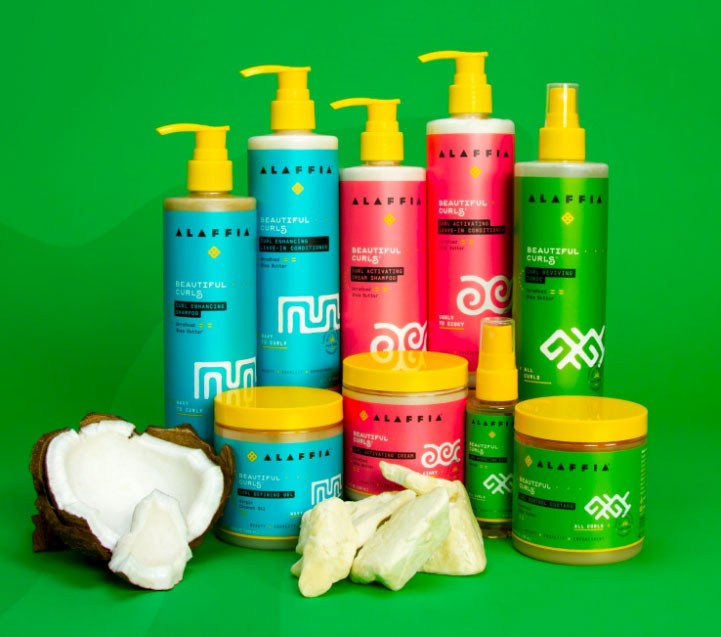
Do you have any tips for those with waves or curls and with fine hair who need moisture but find that moisturizing products can weigh their hair down or make the roots look oily sooner?
A curly girl’s best friend is water, but thin curls can easily become their enemy if they apply too much product. My clients ask me this question all the time, usually after much trial and error. I always recommend that those with fine textures start applying product at the mid-shaft to the ends of the hair. This way, you are giving your curls the moisture they need without the risk of weighing them down. Make sure that you apply while the hair is still wet—this allows the product to soak into each strand properly and gives the best result. This is exactly how I like to apply the Beautiful Curls Curl Enhancing Leave-in Conditioner to ensure curls are enhanced and defined every time.”
Do you have any unique finger styling or curl defining techniques that you use on wavy or curly clients for applying the Beautiful Curls Curl Defining Gel?
Antoine: “Get it wet! Just like your leave-in, you definitely want to make sure you are applying the Beautiful Curls Curl Defining Gel to completely wet hair. As you apply the defining gel, take small sections at a time and finger comb them from roots to ends. Your curls will be shaped and defined all over as a result. After that, air dry your hair, or use a diffuser to add more volume.”
How do you recommend curly haired folks refresh their second- or third-day curls with Beautiful Curls?
Antoine: “You have to get your hands on the Beautiful Curls Curl Reviving Tonic—it’s a texturizing mist that rehydrates and re-shapes your curls without adding too much product that could weigh them down. It is an easy way to restore your curls at home that I recommend at the salon all the time. Use your fingers to recurl small sections at a time after misting all over. As a result, you will be able to define your hair while removing any excess frizz. On days when your curls need a little more moisture, mix a little Curl Enhancing Leave-in with water in a spray bottle, shake it up and use it as a moisture mist. The frizz disappears easily, and I’ve done it for years. When I’m on set for a photoshoot and the curls of my client get unruly from all the hot lights, this method works like a charm.”
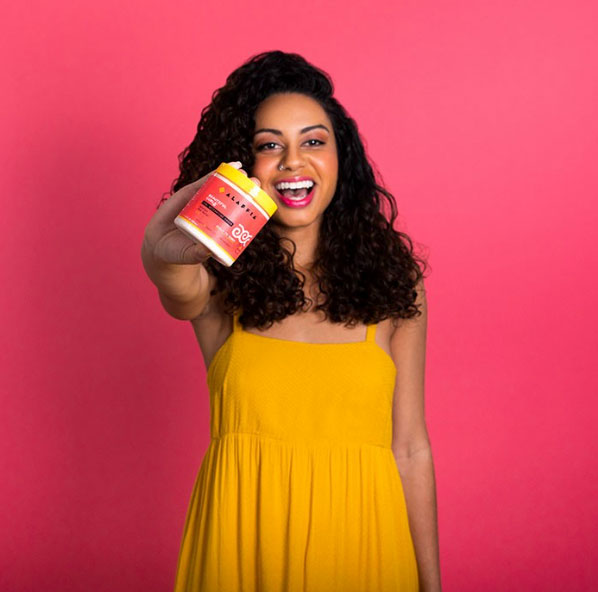
We know that Beautiful Curls Curl Activating Leave-In Conditioner can be used to moisturize and detangle, do you have any other detangling tips for those with curls to reach maximum potential curl definition with this product?
Antoine: “The Beautiful Curls Curl Activating Leave-in Conditioner is a fantastic product that can be used in a few different ways. Firstly, you can apply this as a pre-poo to detangle before you wash. Then, it can be used after shampooing—apply the product in sections and comb through to ensure even distribution of the product throughout your hair. Keep in mind that because this product is lightweight for tighter textures, your curl will start expanding shortly after the hair is dry.”
Is it possible to make a twist-out or braid-out last longer when using the Curl Activating Cream?
Antoine: Make sure to use Beautiful Curls Curl Activating Cream after applying the Curl Activating Leave-in when your hair is wet. Together, these two products give your hair maximum hydration and definition while minimizing frizz. Then, leave it in for at least a full day before you take it down. Your curls will remain the longer you leave the style in, and the more defined your curls will be.”
The Curl Activating Cream can be used with a diffuser for volume, do you have tips for those with curls who find that when they diffuse it can create frizz?
Antoine: Moving the diffuser rapidly is what causes the frizz. Getting into the habit of taking your time is all it takes to make a huge difference while diffusing.” Hold the diffuser in one position for 20 seconds before moving to the next section of hair.
How often would you recommend people who use the Beautiful Curls Shampoos to remove product buildup, sweat or oil, but who also want to retain moisture and not dry out their curls, coils or waves?
Antoine: Looser curl patterns and waves can be washed more frequently than tighter curls and coils. Since Beautiful Curls shampoos are sulfate-free, it means that using the product will not strip your hair the way a traditional shampoo would, however, limit your wash days to every 7 to 10 days for best results.” “I recommend washing once a week or once every week and a half, depending on your hair type.
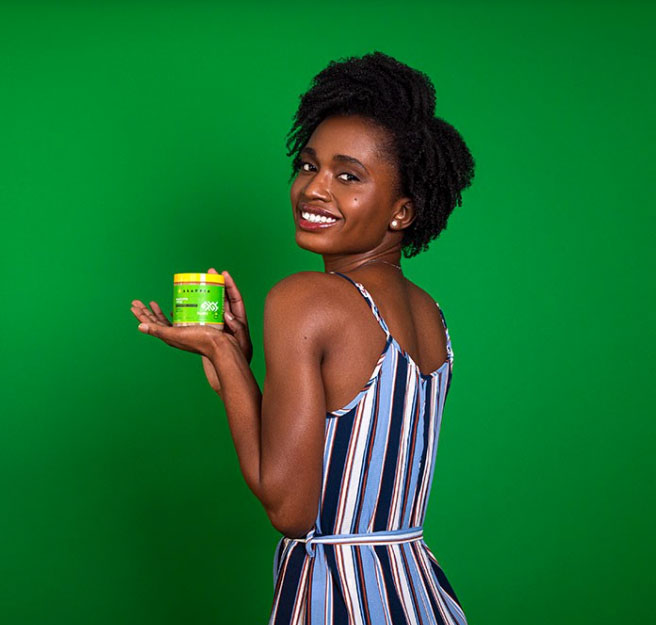
What coil defining techniques would you recommend while using the Curl Control Custard for a lasting and defined wash-and-go?
Antoine: “When you are looking to do a wash-and-go, you want to make sure you thoroughly detangle your hair all over before applying any styler. This will make the application of the Curl Control Custard an easier and smoother process. Always apply the product from root to ends in small sections. Once the hair is dry, scrunch for added volume.”
Any other frizz fighting tips for the summer?
Antoine: “Cocktails were made for the summertime—and I’m not just talking about happy hour. Cocktailing stylers together can help to give your curls a surge of hydration to minimize frizz and keep them looking their best. I like to pair something super hydrating, like one of our Beautiful Curls Leave-Ins with a styler that helps to retain the moisture and give your curls enough hold, like the Curl Defining Gel or Curl Activating Cream (when you need extra hold). Always, make sure you choose products like Beautiful Curls that are clean—meaning no sulfates, silicones, parabens and phthalates.”
This post is sponsored by Alaffia.
6 Foods That Will Make Your Natural Hair Grow Faster
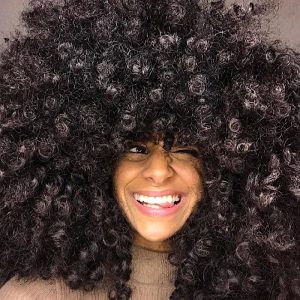 6 Foods That Will Make Your Natural Hair Grow Faster
6 Foods That Will Make Your Natural Hair Grow Faster
While you might not feel it just yet, the spring season is just a few weeks away. That means warmer weather, blooming flowers, singing birds—and time to create a hair regimen that will keep your tresses as beautiful as ever. Although there are tons of commercial products on the market that will make your curls—pun intended—spring up, there are also some in-season foods during the springtime that you should stock up on. Foods that are delicious, affordable and have a real knack for keeping hair strong and healthy, right into the summer.
1. Strawberries
It’s kind of crazy that, something so sweet, can actually be really good for you. But such is the case with strawberries. This fruit is one that is super high in antioxidants like Vitamin C as well as potassium, folate and manganese. Fiber and protein are in strawberries too. Health-wise, they are the kind of fruit that regulates your blood sugar levels, protects your heart and provides relief from arthritis-related symptoms. Also, the salicylic acid, alpha hydroxy acid and ellagic acid that’s in strawberries can help to prevent hyperpigmentation in your skin, as its anthocyanins and antioxidant properties will keep free radicals at bay. Although magnesium, omega 3 fatty acids and copper are not in super high amounts in this particular fruit, it’s enough to nourish your hair follicles while Vitamin C removes excess sebum from your scalp that could clog your follicles and hinder healthy hair growth.
How to Use Strawberries: If you want to remove excess build-up from your hair without drying it out in the process, all you need to do is mash up five strawberries with two tablespoons of plain yogurt and a teaspoon of honey. Apply the mask to your hair, right after washing it. Let it penetrate your hair shaft for 15-20 minutes. Then rinse and deep condition your tresses.
2. Chayote Squash
Chayote Squash is the kind of squash that is in peak freshness during the spring. It has protein, fiber, vitamins B6, B9, C and K, as well as copper, zinc, magnesium, fiber and manganese in it (for starters). As for overall health benefits go, chayote squash contains antioxidants that reduce body inflammation, folate to keep your pregnancy healthy and nutrients to delay the signs of aging. It’s great for your hair because the combination of the nutrients can delay greying, reduce breakage and strengthen your strands.
How to Use Chayote Squash: Here at Naturally Curly, we’re super fond of squash. So much, in fact, what we wrote an entire feature on winter squash. Try a recipe for winter squash to accomplish better length retention; equally as interchangeable with chayote squash.
3. Mint
Mint is an herb that is rich in all kinds of nutrients. It contains iron, folate, manganese and Vitamin A, and is able to do everything from improve irritable bowel syndrome and relieve cold symptoms to strengthen your brain function. The reason why you should consider using it on your scalp and hair is because the menthol in mint is great at increasing blood circulation to your hair follicles, plus its antimicrobial and antifungal properties can keep dandruff-causing fungus at bay. Mint is also a great source of carotene and antioxidants; both work together to provide your follicles with the nutrients that they need in order for your hair to stay healthy and strong.
How to Use Mint: Crush 5-10 mint leaves together. Add a tablespoon of fresh lemon juice and a teaspoon of melted coconut oil. Apply it to your freshly washed scalp. Let it sit for an hour and then rinse thoroughly. It will invigorate your scalp while removing unnecessary fungi and dandruff flakes too.
4. Kiwi
Kiwi might be tiny, but it makes a really big difference. Thanks to vitamins A, C, B6, B12 and E, along with potassium, calcium, iron and magnesium, kiwi has the ability to boost your immune system, regulate your blood pressure, reduce oxidative stress, protect your vision and even help you to sleep soundly. Something else that kiwi has in it is zinc. Our hair needs lots of that in order to prevent dandruff, hair loss and strengthen our tresses. Eating and applying kiwi can only benefit your hair, long-term.
How to Use Kiwi: One way to use kiwi in order to prevent hair premature greying while strengthening your locks in the process is to combine a tablespoon of fresh kiwi pulp with a teaspoon of Vitamin E and a teaspoon of henna. Apply the solution to your hair and scalp. Put on a plastic bag and let it sit for an hour. Then shampoo, condition and style as usual.
5. Mangoes
If there’s one reason to get hype about spring’s return, it’s because mangoes tend to be at their peak of freshness. Not only do they taste amazing, but they are high in vitamins A, B6, C, E as well as fiber, potassium, folate, calcium and zinc. When it comes to this particular fruit’s health benefits, mangoes are able to lower cholesterol, promote eye and gut health, manage diabetes, treat anemia and delay the physical signs of aging. Mangoes are the perfect “hair fruit” because it contains about 83 percent water; that, along with the E and zinc that is in them, makes mangoes a wonderful ingredient for hair conditioners and moisturizers.
How to Use Mangoes: Are you looking for relief from dry brittle hair, we’ve totally got you. Check out the Naturally Curly article, “DIY Mango Mask and Butter for Dry Hair” for a recipe that will provide your hair with more moisture than ever.
6. Bee Pollen
When you really stop to think about it, it makes perfect sense that bee pollen would be in season during the spring season since bees are back in abundance during that time of year. Bee pollen is high in protein, amino acids, flavonoids, phosphorus, potassium and selenium. Because of this, it’s able to prevent liver toxicity, strengthen immunity, relieve stress, reduce menopausal symptoms and promote overall healing. Something else that’s awesome about bee pollen is it has L‑Cysteine in it; it’s an amino acid that is full of sulfur which is something that our hair needs in order to grow without breaking. The vitamins A and E that’s in the pollen can keep your hair moisturized too.
How to Use Bee Pollen: If you want an all-natural way to treat hair loss, add a tablespoon of bee pollen to your shampoo. You should see results in as little as a month if you do.
Enjoy these foods—and the spring season that is on its way! And share with us if you try them out as well!
Stop Making These Tangle-Causing Mistakes
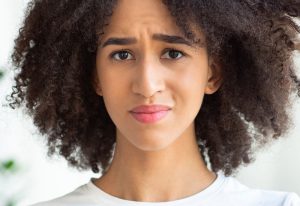
It is quite disappointing to discover that your hair is tangled shortly after washday. Especially when your curl friends do not really face the same challenge with their curls.
“How does my hair tangle so quickly?” you may wonder.
Luckily, we will share the most common causes of tangled curls in this article and how to avoid tearing your hair out.
1. Not using the right deep-conditioner
Knowing the porosity of your hair is key when purchasing a deep-conditioner. Many curlies base their purchase decision on reviews of a popular blogger, who may have a different hair porosity. A suitable deep-conditioner will restore the condition of the cuticle and improve its ability to absorb and restore moisture. For instance, someone who has low porosity hair should avoid using protein deep-conditioners. On the other hand, someone who has high porosity hair needs protein to restore the damaged cuticles.
2. Not detangling your hair correctly
There are many ways of detangling curls incorrectly. For instance, some people mostly detangle the ends of their hair, but fail to detangle the roots thoroughly. As a result, they often have tangles in their roots. Others do not section their hair prior to detangling. Consequently, it is easy to overlook areas to detangle. When detangling incorrectly, your strands will get cluttered with other strands. As a result, there will be knots in the hair.
Prior to detangling your hair you should divide your hair into sections. Start detangling your hair at the ends and carefully detangle up to the roots. If you are able to smoothly run the comb from the roots to the ends you have detangle your hair correctly.
3. Postponing wash days
Making the washday results last as long as possible is preferred by many curlies. However, your hair really needs moisture. Without moisture, your hair will be brittle and rough. As a result, your strands will get tangled. To prevent this from happening, schedule a wash morning, afternoon or evening during the week.
4. Product build up
LOC or LCO are curly hair methods, which are often recommended by many curly hair gurus. Unfortunately, these curly hair care methods are not suitable for every hair porosity. For instance, applying too many products on low porosity hair will cause product build-up. As a result, the hair will get tangled easily. Curious about which type of products would match your curly hair needs? Then you should read this article.
5. The wrong nighttime routine
Hair tangling can be caused by friction between the hair cuticles as they move and rub against each other. The friction occurs when your head moves during your sleep. Braids, a pineapple bun, wearing a satin scarf or bonnet are ways to prevent your hair from tangling.
6. You do not trim your hair consistently
It may be tempting to avoid a visit to the hairdresser, but trimming your curls prevents your strands from tangling. Split ends will cause friction with other ends. As a result, you will have tangles and fairy knots. Visit the hairdresser every three months to prevent this from happening.
7. You should try low manipulation styling
Wash and go may be perceived as a never-ending battle. Especially, when the washday results last less than two days. If you want to give yourself a break, you should try low manipulation styling, such as flexi-rods, roller sets, banding, curlformers and heatless blowouts. To achieve excellent results you will have to detangle every strand carefully. Low manipulation hair styling will not require lots of effort the days after washdays. Besides, you will be tempted to follow most of the good habits. For instance, to achieve beautiful results you will encourage yourself to detangle your hair correctly. Not to forget, as it took quite some effort to achieve excellent results, you will follow the right nighttime routine to make sure that you will continue having good hair days.
8. Your clothing causes friction
Wearing a scarf or a jacket or top with a high collar can be warm, fashionable and comfortable; however, if you are not wearing a silk scarf the moisture will be absorbed by the material of the garment. Thus, the hair will tangle. Try not to wear your hair down when rocking a scarf or clothing that will rub on your hair.
10 Curly Hair Terms Every Natural Should Know By Now
Still not quite understanding all the natural hair terminology you read and hear from the community? Here are the 10 curly terms every natural should know!
Visit our glossary below for more terms and definitions that our community uses.

Co-washing
Co-washing is using a cleansing conditioner to wash hair instead of a shampoo. These conditioners do not contain silicones, parabens, or sulfates, and many have cleansing agents that are gentler than shampoo. Here is your curly hair guide to co-washing.
Deep Conditioning Treatment
A deep conditioning treatment is used for the purpose of repairing and reconstructing the hair from manipulation and provide more moisture. There are is a difference between deep conditioners. There’re light deep conditioning treatments should be used weekly then there’re heavy –protein based deep conditioning treatments that should be used every 4-6 weeks. Refer to these deep conditioning do’s and don’ts to know what you’re doing wrong.
Dusting
Not as harsh as a trim, dusting is the light trimming of your natural ends. You should dust those old ends to get rid of split ends and prevent unwanted breakage. To keep your ends healthy, dust your hair about every 6-8 weeks.
Elasticity
Elasticity is a term used to describe how a material responds to the application and removal of a specific type of mechanical load–i.e., pulling and/or bending. Elasticity is a huge indicator of healthy hair, and what gives it the ability to withhold stress. When your curls loses elasticity, they lack curl retention and become prone to more breakage. Maintain your hair’s elasticity and moisture by doing regular deep conditioning and protein treatments.
Pre-poo
Pre-poo is an oil treatment applied to the hair prior to shampooing. This helps to combat the drying and tangling from the shampoo stripping the hair’s natural oils. Pre-poo your hair with a light oil such as coconut that gives your hair slip to work through tough strands. Here are some tips for making the most of your pre-poo.
Heat Damage
Heat Damage occurs when direct heat breaks and disrupts your natural curl pattern. Heat damage causes a lost of your hair’s elasticity and prevent it from returning to its natural curl pattern. When heat styling your hair, always use a heat protectant and use a lower heat setting on your straightening iron. Are you in heat damage denial? Find out now.
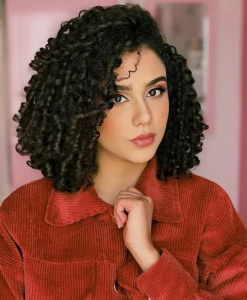
Over-manipulation
Over-manipulation is the stress and constant pulling on your hair shaft. Daily styling, washing, detangling are other forms of over manipulation. Even protective styles can cause over-manipulation to your hair. Choose styles that protect your hair from over-manipulation such as wash-n-go’s. Look for a guide to low manipulation styles.
Porosity
Porosity is used to determine how your hair absorbs moisture. Hair that losses moisture and constantly dry, is defined as high-porosity. While low porosity hair doesn’t accept moisture or lose moisture so easily. Here’s how to find out your hair porosity level.
Slip
This describes how well or poor a product lubricates the hair for an easier detangling process. Slip is great for those that have a struggle with knots, webbing, and tough tangles. Detanglers and hair milks that provide great slip have ingredients such as water and marshmallow root, flaxseed. View this ingredient list to know how to look for slip.
Shrinkage
A term to describe the loss of inches of our natural hair. All naturals know the struggle and fight shrinkage because it hides our real hair length. However, there are ways we can stretch our hair and elongate the hair strands. Start putting your hair in styles that stretch the curls, such as flat twists and stay away from the wash-n-go.
Photos by Celeste Images
These Products Were Made to Fight Hair Loss from Weaves & Color Damage

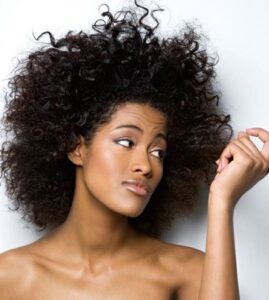 Jesseca Dupart is one to watch. After a devastating fire in 2014m she was led to launching a new haircare product line. She calls it Kaleidoscope Hair Products. The focus of the brand is to help clients who were experiencing hair loss caused by weaves and color damage, and to recover with flourishing new hair growth. Kaleidoscope is one of the fastest growing brands in the haircare industry, due in part to their retail partnerships with CVS, Walgreens, Rite Aid, and more.
Jesseca Dupart is one to watch. After a devastating fire in 2014m she was led to launching a new haircare product line. She calls it Kaleidoscope Hair Products. The focus of the brand is to help clients who were experiencing hair loss caused by weaves and color damage, and to recover with flourishing new hair growth. Kaleidoscope is one of the fastest growing brands in the haircare industry, due in part to their retail partnerships with CVS, Walgreens, Rite Aid, and more.
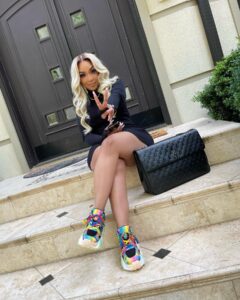 Jesseca spoke about her entrepreneurial journey, hair growth tips, and her faith in the article below.
Jesseca spoke about her entrepreneurial journey, hair growth tips, and her faith in the article below.
Miracle is one of Kaleidoscope’s most popular collections. This collection includes 5 staple products and the Miracle Drops Hair and Scalp oil. In this collection, the same formula is used as the best-selling Miracle Drops oil.
Do you remember how you felt about your hair while you were growing up?
From a young age, I can remember cutting and styling my dolls’ hair. One fond childhood memory I have is sitting on my dad’s back and filling his entire head with barrettes. He would let me play around like that all the time. Somehow that grew and by the time I was in middle school I was doing all of my friends’ hair along with my own.
How would you describe your entrepreneurial journey to creating Kaleidoscope?
That’s the best way to describe it as a crazy whirlwind. What started as something I was offering to my clients (I was a hairstylist for over 20 years) became something that retired me from the chair. Learning to leverage social media while offering products that work proved to be the perfect synergy for growth. I have enjoyed taking over social media over the years because it has allowed me to be creative unapologetically.
When reopened your business after the fire in 2014, what were some business strategies you applied to the new salon?
- Fiscal responsibility
- Marketing
- Also letting go of any fear!
In your opinion, what are the most important ingredients in hair care?
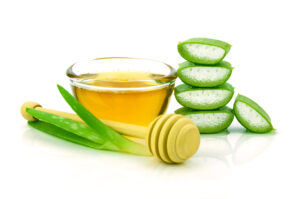
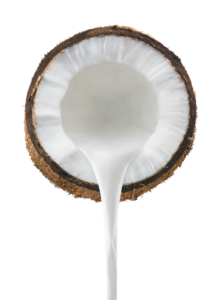
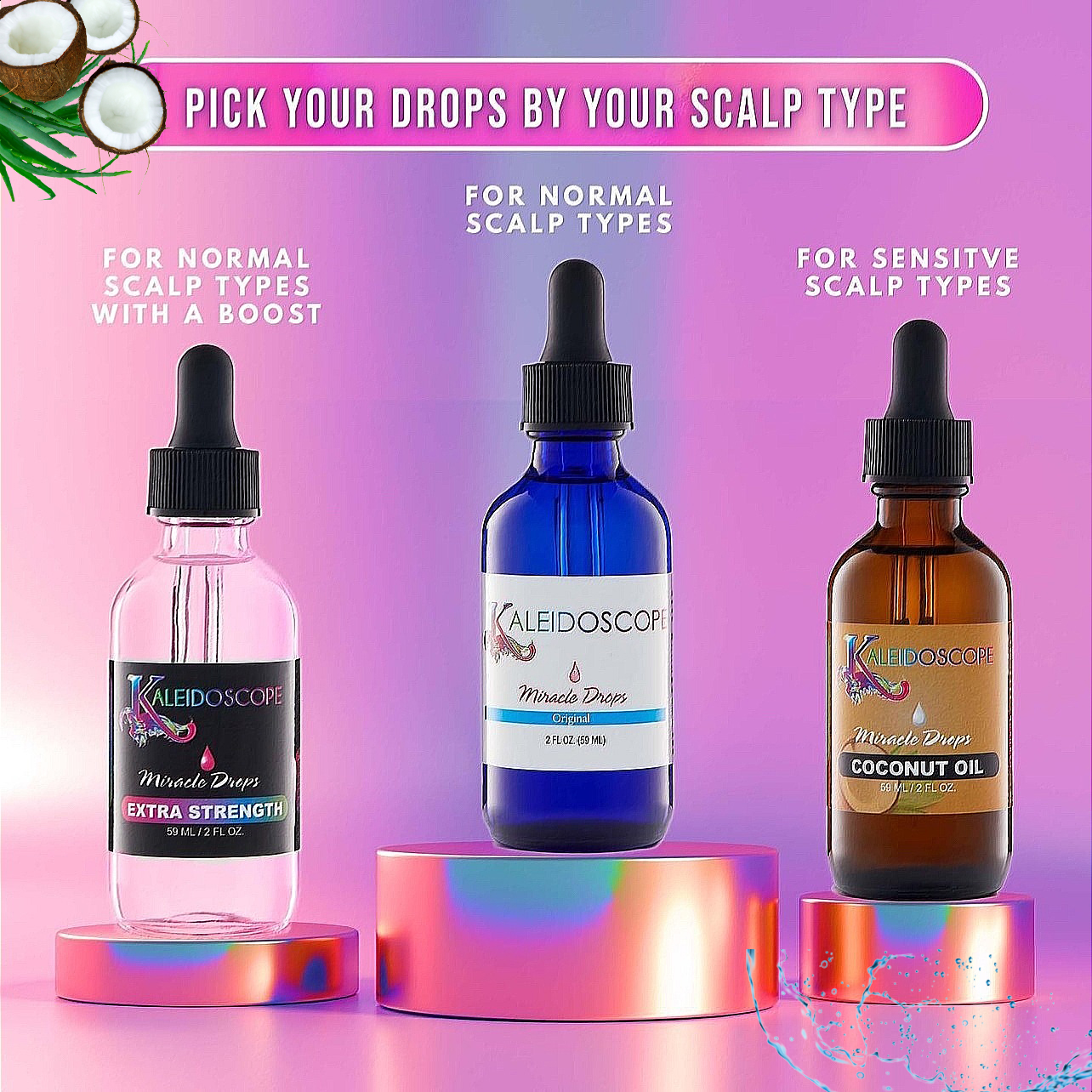
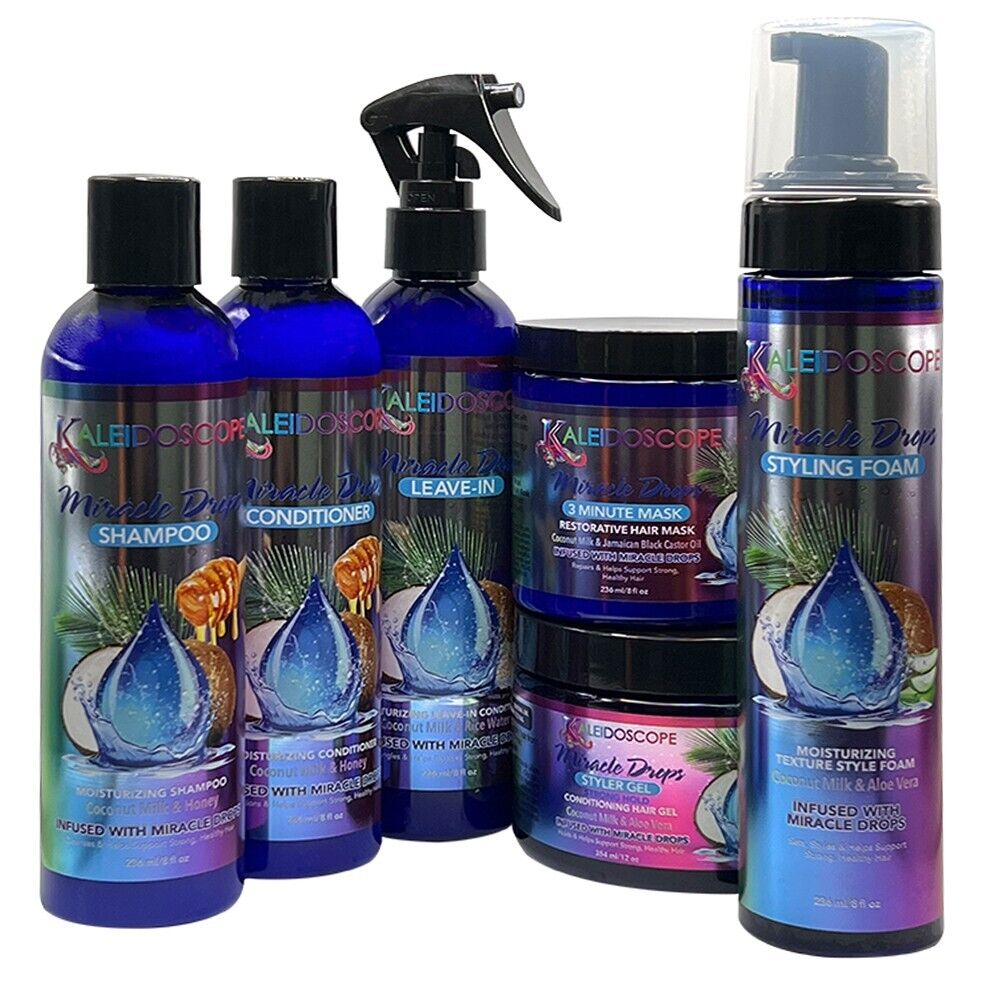
Your best-selling product is the Miracle Drops which focus on hair growth. What was your inspiration for the Miracle Drops line?
With our customers loving Miracle Drops (Original, Extra Strength, Coconut), and Miracle Drops already being in our edge pomade and leave-in conditioner, it was only a matter of time before we extended the formula to the entire collection. I figured this was the best way to conquer two of the most common hair concerns – length retention and lack of moisture – all at once.
Hair growth is an essential focus for your brand and products, what has your experience been with hair growth?
Like many, I have colored my hair multiple times, and for the most part I am able to bounce back. It was the last time I colored my hair in particular that almost forced me to transition to be fully natural. It has been quite an exciting journey growing out my curls. During this time I did a lot of research to develop the perfect formulation for the Miracle Drops Collection.
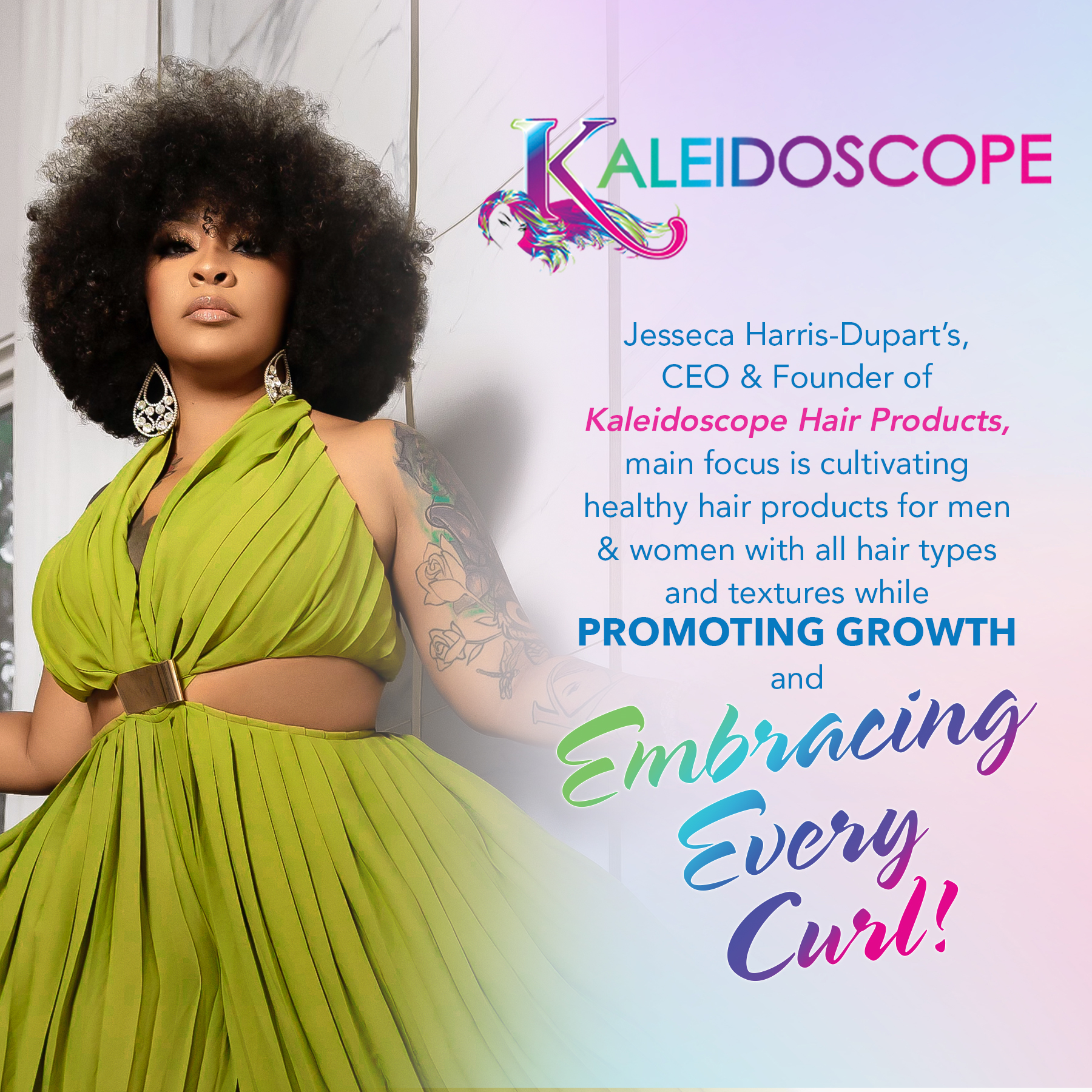
Jesseca “Judy” Harris-Dupart
How Elaine Gets Her Naturally Wavy Hair to Look Like This
This answer is easy as they had such a noticeable effect! The trick that has made the biggest difference is protecting my curls overnight with a silk scarf, as my hair has always been too fine for pineappling. Then I hydrate daily by spritzing my hair every morning with a mix of water and leave-in conditioner. Can you believe I actually used to avoid conditioning as I thought it weighed my curls down? But only because I had been using generic cosmetic conditioners that were laden with heavy silicones. Lush curls need hydration!
Another fave is nightly scalp massages. This has massively improved the health of my scalp, my issues with protein sensitive itching, hair growth, achieving 2nd, 3rd and 4th day curls and the benefits go on. I will never not do this now.
What piece of advice would you give to a curly who's just starting out in their journey?
My advice to those starting their journey, or restarting for the umpteenth time, would be to not get too caught up in others' routines, products and methods. It is so inspiring to follow other curly girls, and there is no doubt that you will gain valuable support and help from the amazing curl community, but everyone's curls are so unique and what works for others wont necessarily work for you! There are no wonder products to reverse damage, so take the time to nourish and care for your curls until they are healthy, learn what feels good, and what doesn't, pay attention to what ingredients feature in your fave products to help determine what to look for in others. Oh and take lots of selfies... any time you're having a bad hair day, or feeling frustrated, remind yourself just how far you have come, and I guarantee that pic from 3 months ago will help you realize that your curls are improving every day. Even on your worst curl day, there will be another girl 6 months behind you who dreams of getting to where you are now!
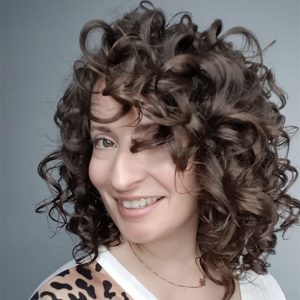
My advice to those starting their journey, or restarting for the umpteenth time, would be to not get too caught up in others' routines
6 Must-Know Tips For Softer Summer Curls
Dry, crunchy, crispy hair isn’t cute.
No one in the history of hair has gone on record raving about having luxurious, parched curls. I’m not talking about gel casts from styling products that you can easily scrunch out
with a dab of oil or serum–but inherently dry, dehydrated, borderline tumbleweed hair. Summer heat is notorious for parching our curls, here’s how to keep them soft all season.
1. Drink water
If you have chronically dry hair, your products may not be to blame. Do you drink enough water? One of the keys to healthy, soft and strong hair is keep it hydrated.
That starts from the inside out. If you have dry hair, ask
yourself how much water do I consume daily? The hair shaft is comprised of about 25% water, so drink up. Your hair, skin, and insides will thank you.
2. Pre-poo
When curly girls start cutting regimen corners, one of the first things to go is the pre-poo. A good pre-poo is essential to soft hair. They are meant to prime the hair for cleansing by softening,
strengthening, and easing the detangling process. They also prevent cleansing products from robbing the hair of critical moisture.
3. Shampoo (instead of co-wash)
You may be active or outside in the heat more during the summer, and cleansing becomes even more important for a clean hair and scalp. While co-washing is a great
alternative to always using shampoo, it doesn’t quite remove all the buildup and eventually, your hair will not respond the same way to the co-wash (due to buildup).
Additionally, shampooing makes your conditioner work more effectively. Generally, hair carries a slight negative charge that is enhanced by use of a shampoo with a negative charge. Conditioner has a positive charge, and we all know that opposites attract. The ingredients in regular and deep conditioners are designed to stick to the hair, smoothing the cuticle, and filling in the chipped areas. This functionality and improved softness is enhanced with the use of shampoo.
4. Deeply treat with steam
Steaming the hair gently lifts the cuticle and allows the warm water to penetrate the hair, hydrating it thoroughly. Hydrated hair is soft hair, and soft hair maintains a proper moisture balance provides optimal elasticity. Steam treatments can be done on wash days, mid-week to refresh curls, or while deep conditioning.
Here’s a hack for steaming hair for free (if you don’t have a handheld one): let your hair hang loose during your next shower. You may also spritz it with hot water and covering with a plastic cap and sitting under a dryer for indirect heat to enhance your deep conditioner properties.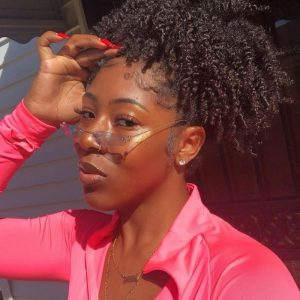
5. Deep condition more frequently
Do you deep condition every time you wash your hair? If you don’t, you should try it. It’s the single piece of advice that unites all naturals, regardless of regimen and hair type. Deep conditioning does a curly mane good, in terms of softness and moisture. Depending on your hair type and regimen, you may not need to deep condition every time, but do consider increasing the frequency if your hair starts to feel parched or brittle.
6. Layer with a leave-in
Whether you are using a daily conditioner or a product formulated specifically as a leave-in, having a product that is a water-based mixture of fatty alcohols, emollients, and humectants is the first line of defense in maintaining soft hair. Use a moisturizer to lock in the hydration from your leave-in and prime your hair for styling. If your hair responds well to pure oils and butter, seal your curls with an oil.
Repairing Thin Edges
When it comes to being natural, there are a few concerns most of us share. We need tips for detangling, moisturizing, and styling our hair. But there’s one thing some of us (me included) have just not gotten the hang of: Thinning edges.
I’m sure we all saw Naomi Campbell’s picture floating around the Internet, on some natural hair thread or at the bottom of a very long forwarding list.
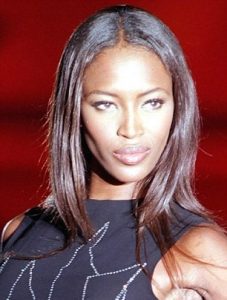
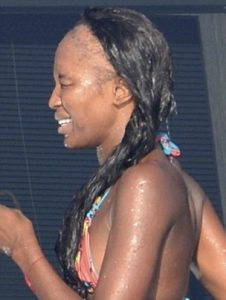
When we talk about thinning hair, we mean that the number of hairs on our head is decreasing. We are losing (or failing to grow) whole strands of hair. Hair loss is mostly a result of a damaged hair follicle. The follicle is a part of the skin/scalp that packs old cells together to form a strand of hair. It starts below the visible surface of the skin but sticks up a tiny bit (that’s why we get goosebumps).
And while hair loss can be a sign of a more serious problem or a result of medications (think: chemotherapy), the average person can work to correct thinning hair.
The follicle can be damaged by a number of things: chemicals from hair color, relaxers, and vitamin deficiencies. Constant tension on the hair can stress the follicle as well.
Learn what caused your thinning edges.
If it is in your control, STOP doing whatever it was that caused it altogether. Again, if it is a result of a more serious condition, consult your physician.
No matter the texture, everybody has some “baby hair”—the shorter, finer, wispier hair that frames our face…and sticks out of ponytails. But I think those of us with coily, or kinky hair experience thinning edges because of the wider variety of styling options we use. I really wanted kinky twists this summer, but I knew my edges couldn’t take it. The twists may have been cute … but a bald spot in the corner wouldn’t be. The type of thinning edges caused by hair styling is called mechanical or traction alopecia.
Healthy hair will flourish. So we must create and preserve healthy conditions.
The first thing to understand is that there is NO set “regimen” for growing your hair in general or edges in particular. No product, whether natural or man-made will cause the hair to safely grow faster. It is true, however, that certain ingredients allow the hair to grow better. All they do is create the best possible conditions for your hair to grow to it’s fullest potential.
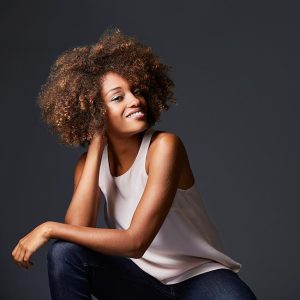
Apply growth aids & DHT blockers directly to the hair or scalp!
Growth aids can include oils that you may already be familiar with: grape seed, castor, vatika, avocado, and henna amla oil. Natural growth aids like cinnamon and peppermint extract must be mixed with a carrier oil. They are so potent they may cause irritation, even after dilution so perform a patch test to avoid allergic reactions.
For hair thinning prevention and to reduce hair loss, you will need a DHT blocker. DHT, or Dihydrotestosterone, is a hormone produced by all human beings. When DHT binds to the hair follicle, hair thins and falls out. Since your goal is to reduce the likelihood of thinning edges and hair, you absolutely need DHT blocking treatments like Groganics Hair Growth Treatment to help to increase blood flow to your scalp, prevent breakage, and maintain follicle health.
As nourishing your body indirectly nourishes your hair, you can also apply certain ingredients directly to the scalp and hair. Products that promote a healthy hair and hair follicle either:
-
Keep the follicle clean, prevent clogged follicles
-
Stimulate the scalp
-
Seal in moisture, prevent breakage
-
Provide protein, fill gaps in the hair cuticle, give it strength
Try one or two of these oils and/or treatments in moderation. Start off slowly, changing maybe one or two things in your regimen, whether more exercise or doing monthly egg deep conditioning treatments.
NOTE: Too much protein can actually give the hair too much structure, and not enough moisture and flexibility. We’re looking for long-term results, not a quick fix.
It’s not uncommon to start looking for natural and/or organic products for your hair. After all, your natural curls are relatively new (especially if you Big Chopped). You haven’t developed any habits for your new hair, so it’s easier to begin forming healthier ones. And as the above tips show, trying to thicken your hair will most certainly cause a healthier body in the process.
Happy growing!

